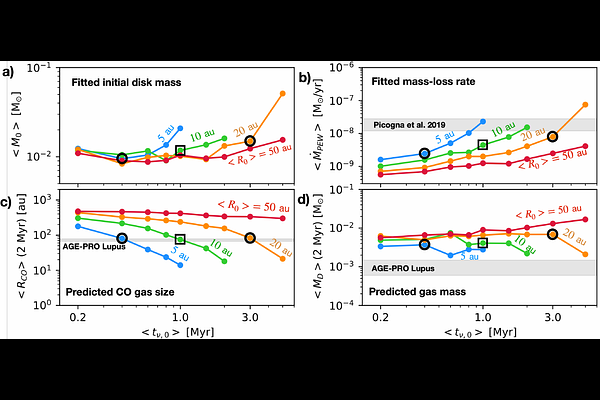The ALMA Survey of Gas Evolution of PROtoplanetary Disks (AGE-PRO): VII. Testing accretion mechanisms from disk population synthesis

The ALMA Survey of Gas Evolution of PROtoplanetary Disks (AGE-PRO): VII. Testing accretion mechanisms from disk population synthesis
Benoît Tabone, Giovanni P. Rosotti, Leon Trapman, Paola Pinilla, Ilaria Pascucci, Alice Somigliana, Richard Alexander, Miguel Vioque, Rossella Anania, Aleksandra Kuznetsova, Ke Zhang, Laura M. Pérez, Lucas A. Cieza, John Carpenter, Dingshan Deng, Carolina Agurto-Gangas, Dary A. Ruíz-Rodríguez, Anibal Sierra, Nicolás T. Kurtovic, James Miley, Camilo González-Ruilova, Estephani TorresVillanueva, Michiel R. Hogerheijde, Kamber Schwarz, Claudia Toci, Leonardo Testi, Giuseppe Lodato
AbstractThe architecture of planetary systems depends on the evolution of the disks in which they form. In this work, we develop a population synthesis approach to interpret the AGE-PRO measurements of disk gas mass and size considering two scenarios: turbulence-driven evolution with photoevaporative winds and MHD disk-wind-driven evolution. A systematic method is proposed to constrain the distribution of disk parameters from the disk fractions, accretion rates, disk gas masses, and CO gas sizes. We find that turbulence-driven accretion with initially compact disks ($R_0 \simeq 5-20~$au), low mass-loss rates, and relatively long viscous timescales ($t_{\nu,0} \simeq 0.4-3~$Myr or $\alpha_{SS} \simeq 2-4 \times 10^{-4}$) can reproduce the disk fraction and gas sizes. However, the distribution of apparent disk lifetime defined as the $M_D/\dot{M}_*$ ratio is severely overestimated by turbulence-driven models. On the other hand, MHD wind-driven accretion can reproduce the bulk properties of the disk populations from Ophiuchus to Upper Sco assuming compact disks with an initial magnetization of about $\beta \simeq 10^5$ ($\alpha_{DW} \simeq 0.5-1 \times 10^{-3}$) and a magnetic field that declines with time. More studies are needed to confirm the low masses found by AGE-PRO, notably for compact disks that question turbulence-driven accretion. The constrained synthetic disk populations can now be used for realistic planet population models to interpret the properties of planetary systems on a statistical basis.